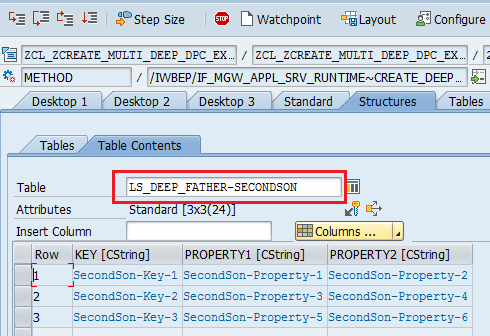
- SAP Community
- Products and Technology
- Technology
- Technology Blogs by SAP
- How to implement multi-level create deep
- Subscribe to RSS Feed
- Mark as New
- Mark as Read
- Bookmark
- Subscribe
- Printer Friendly Page
- Report Inappropriate Content
This blog will explain how to implement multi-level create deep.
Prerequisite, please make sure you are familiar with create deep implementation via Gateway:
Step by Step development for CREATE_DEEP_ENTITY operation
For multi-level create deep, we assume this following scenario:

Here, FirstSon & SecondSon are the first-level deep of father, FirstGrandSon is the first-level of FirstSon but second-level of Father.
Then How to implement this create-deep scenario?
1. Create entities/associations in SEGW which map to this relationship.
Four entities are created: Father/FirstSon/SecondSon/FirstGrandson; Each entity has three properties: Key/Property1/Property2
Three associations are created: "Father to FirstSon" & "Father to SecondSon" & "FirstSon to FirstGrandSon"

2. Generate and register the ODate Service.
I assume you are familiar with these general Gateway steps :smile: .
3. Implement create_deep_entity method.
First create the multi-level deep structure which can holds the nested data from input; Then use io_data_provider to get the input.
Here I just write simple code snippet, as long as we can get nested data in the runtime.

4. Test in RestClient
I used to try to test the multi-level create deep in our traditional GW client and using XML format as payload. Nested data can be transferred into our create_deep_entity method, but the position of the nested data in second level is wrong. Thus, I strongly suggested to use JSON format as payload. Since our GW Client doesn't have a good support json fromat. I recommend to use the RestClient. (In RestClient you have to first get CSRF token and then post)
Payload:
{
"Key": "Father-Key",
"Property1": "Father-Property-1",
"Property2": "Father-Property-2",
"FirstSon": [
{
"Key": "FirstSon-Key-1",
"Property1": "Firstson-Property-1",
"Property2": "Firstson-Property-2",
"FirstGrandson": [
{
"Key": "GrandSon-Key-1",
"Property1": "GrandSon-Property-1",
"Property2": "GrandSon-Property-2"
}
]
},
{
"Key": "FirstSon-Key-2",
"Property1": "Firstson-Property-3",
"Property2": "Firstson-Property-4",
"FirstGrandson": [
{
"Key": "GrandSon-Key-2",
"Property1": "GrandSon-Property-3",
"Property2": "GrandSon-Property-4"
},
{
"Key": "GrandSon-Key-3",
"Property1": "GrandSon-Property-5",
"Property2": "GrandSon-Property-6"
}
]
}
],
"SecondSon": [
{
"Key": "SecondSon-Key-1",
"Property1": "SecondSon-Property-1",
"Property2": "SecondSon-Property-2"
},
{
"Key": "SecondSon-Key-2",
"Property1": "SecondSon-Property-3",
"Property2": "SecondSon-Property-4"
},
{
"Key": "SecondSon-Key-3",
"Property1": "SecondSon-Property-5",
"Property2": "SecondSon-Property-6"
}
]
}
5. Check if the multi-level nested data is mapping to the right position in our runtime.
Father-level data:

Son-level data (deep to father):


Grandson-level data (deep to FirstSon):
FirstSon[1] has one entry; FristSon[2] has two entry; as payload expected.


Now we get the multi-level nested data in the right position, then we can do anything we want in following :smile: .
Hope it helps!
- SAP Managed Tags:
- SAP Gateway
You must be a registered user to add a comment. If you've already registered, sign in. Otherwise, register and sign in.
-
ABAP CDS Views - CDC (Change Data Capture)
2 -
AI
1 -
Analyze Workload Data
1 -
BTP
1 -
Business and IT Integration
2 -
Business application stu
1 -
Business Technology Platform
1 -
Business Trends
1,658 -
Business Trends
93 -
CAP
1 -
cf
1 -
Cloud Foundry
1 -
Confluent
1 -
Customer COE Basics and Fundamentals
1 -
Customer COE Latest and Greatest
3 -
Customer Data Browser app
1 -
Data Analysis Tool
1 -
data migration
1 -
data transfer
1 -
Datasphere
2 -
Event Information
1,400 -
Event Information
66 -
Expert
1 -
Expert Insights
177 -
Expert Insights
298 -
General
1 -
Google cloud
1 -
Google Next'24
1 -
Kafka
1 -
Life at SAP
780 -
Life at SAP
13 -
Migrate your Data App
1 -
MTA
1 -
Network Performance Analysis
1 -
NodeJS
1 -
PDF
1 -
POC
1 -
Product Updates
4,577 -
Product Updates
344 -
Replication Flow
1 -
RisewithSAP
1 -
SAP BTP
1 -
SAP BTP Cloud Foundry
1 -
SAP Cloud ALM
1 -
SAP Cloud Application Programming Model
1 -
SAP Datasphere
2 -
SAP S4HANA Cloud
1 -
SAP S4HANA Migration Cockpit
1 -
Technology Updates
6,873 -
Technology Updates
421 -
Workload Fluctuations
1
- Exploring Integration Options in SAP Datasphere with the focus on using SAP extractors - Part II in Technology Blogs by SAP
- fuzzy search with multiple name fields in Technology Q&A
- Onboarding Users in SAP Quality Issue Resolution in Technology Blogs by SAP
- How to use AI services to translate Picklists in SAP SuccessFactors - An example in Technology Blogs by SAP
- Switch on gCTS (for existing packages) in Technology Blogs by SAP
| User | Count |
|---|---|
| 39 | |
| 25 | |
| 17 | |
| 13 | |
| 7 | |
| 7 | |
| 7 | |
| 7 | |
| 6 | |
| 6 |